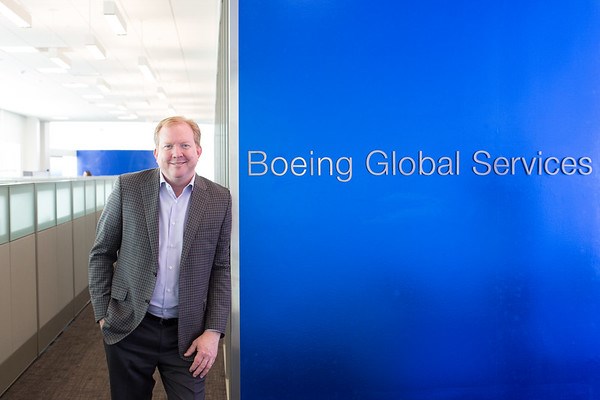There are sunny skies overhead at the Boeing Global Services West Plano headquarters. It’s no coincidence that this brand new wing of The Boeing Company has chosen to roost in a top-floor office where they have settled in nicely. A huge fan turns slowly in a conference area that resembles a futuristic bistro; its legal name is Big Ass Fan. A floor-to-ceiling world-map dominates the entrance and displays the all services operations Boeing has around the world. A window curves around one whole wall, letting in the unfettered Texas horizon.
But the sky itself isn’t very different from the one Stanley Deal—he prefers Stan—remembers over his family’s farm in central Illinois where he fostered a passion for aerospace.
“Airplanes were always flying over because Chanute Air Force Base was nearby. This was back when they still flew supersonic planes. You’d hear the sonic boom, look up and see these amazing, wonderful machines. That inspired me,” Stan recalls. He grew up immersed in the miracles of the Space Race. He was fascinated by the Apollo missions, the Saturn missions and his hero Neil Armstrong’s giant leap for mankind.
Stan has been with Boeing for 30 years. As the world’s largest aerospace company, Boeing is a juggernaut with a proud history. It does business in approximately 150 countries with employees stationed in more than 65. As the U.S.’s largest exporter, Boeing is also a major player in intercontinental business and political spheres. It helped usher in the Space Age with the X-15 hypersonic aircraft, Mercury, Gemini and Apollo programs, and the Jet Age with DC- and 7-series airplanes such as the 707, 737 and 747.
“Fundamentally [Boeing] changed the world because people could get where they were going very economically,” Stan says. “In this century, we’re trying to change the world one more time.”

He and his team oversaw the formation of Boeing Global Services, Boeing’s newest business unit that primarily works to make flying less expensive, more comfortable and safer while updating and maintaining airplanes already in use. For instance, five years ago every pilot carried a briefcase onboard their flight. The case would contain all of the navigational information and charting patterns, as well as the plane’s maintenance records.
“We put all of that on an iPad that can be updated in real time,” Stan explains. It’s a small detail most travellers would never notice. But it has provided pilots with more reliable information that can be accessed more quickly and cut down on their necessary baggage at the same time.
“We put money into innovation,” Stan says. “People who operate airplanes measure their pace in minutes and seconds. Our pace is measured in minutes and seconds too. Agility is very important. We have to see issues before they become issues.”
Applying new technology lowers the cost to the traveler, making flight more accessible for everyone. Advanced health management can diagnose problems with planes before they occur. The average age of an aircraft is increasing with every new discovery.
Last year, Boeing Global Services launched 17 new services. This coming year, Stan has challenged his team to launch 100. He is already thinking far into the future of flight.
“We’re going to see long-term advances like autonomy,” Stan says. “The ability to fly without a pilot, maybe just a controller in the background. The advent of electric propulsion is another advance. It’s a new way to power airplanes and spacecraft.” Today, Boeing is building satellites that carry advanced digital payloads as well as the next commercial crew system, the CST-100 Starliner, that will take men and women back to space.
“Boeing Global Services is doing the training to get people ready to interface with that new technology,” Stan says. “Humankind has a natural tendency to explore. The first great migrations of people were trying to find the boundary of the world. Sailing or flying around the world and then going into space—we have a natural curiosity.”
Everything from space tourism to pilotless planes is on the horizon—and it’s closer than it may appear. Stan estimates that in thirty years air-travel will be transformed; he pictures pilotless crafts that come straight to your door and shuttle you quickly and efficiently across the world, “like getting in your car to go to work.” Once space exploration has advanced and new technologies are developed to lower the cost, space travel will become a viable tourist industry.
People fly every day for business, pleasure and to protect our country. Subtle innovations implemented in minutes and seconds have made what was once impossible into a regular occurrence. By 2050, Stan suggests that we could explore far beyond the moon, beyond Mars and into the solar system at greater speeds than ever imagined.
“Going to the moon was hypothesized in the ‘40s, and then it happened,” he reasons. “A smartphone has a hundred times more computing power than the first Apollo rocket and we carry them in our pockets every day. The entire aerospace industry is a little over a century old. Look what we’ve accomplished in just 100 years. Imagine what’s possible in the next 50.”




